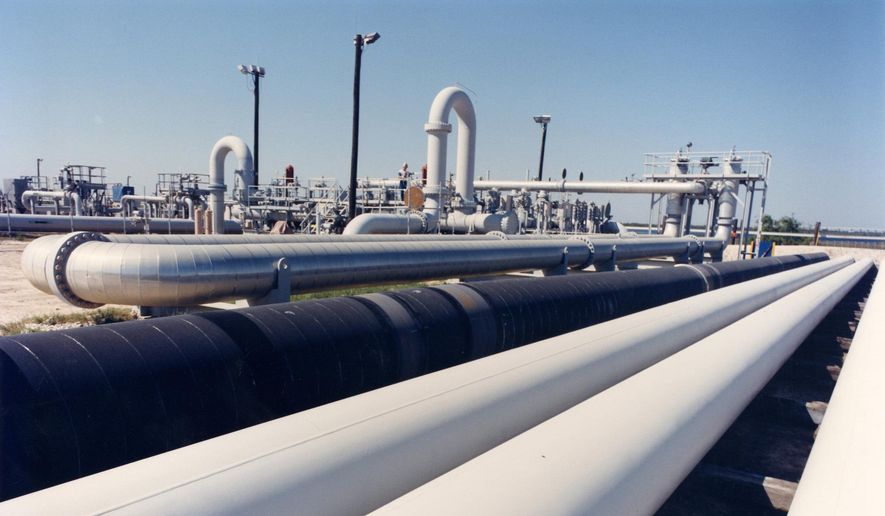DALLAS (AP) — President Joe Biden is again dipping into the nation’s petroleum stockpile to try to corral rising energy prices.
The White House announced Thursday that Biden ordered the daily release of 1 million barrels of oil from the strategic petroleum reserve for the next six months. Biden will also ask Congress to penalize oil and gas companies that lease public land but aren’t producing energy.
The administration hopes that tapping the petroleum reserve will buy time and tamp down gasoline prices long enough until domestic producers can boost output.
Global oil prices were rising even before Russia invaded Ukraine in February. When Biden announced a ban on Russian oil imports in early March, he acknowledged it would come at a cost to American consumers.
This is the third time Biden has turned to the strategic petroleum reserve in a little over four months. Back in November, he ordered the release of 50 million barrels of oil. Then, in his state of the union speech in March, Biden announced another 30 million barrels as part of a multi-nation effort to boost the oil supply.
Tapping the reserve among the few things a president can do alone to try to control inflation, which makes Americans poorer and often creates a political liability for the party in control of the White House.
Here is a look at what’s involved:
___
WHAT IS THE PETROLEUM RESERVE?
America’s Strategic Petroleum Reserve is a collection of underground salt caverns in Texas and Louisiana that can hold more than 700 million barrels of oil, although it is not currently full. The reserve held about 568 million barrels last week, down from more than 650 million barrels in mid-2021, according to the U.S. Energy Department.
The reserve was created after the 1970s Arab oil embargo to give the United States a supply that could be used in an emergency.
___
WHY IS IT USED?
The U.S. now exports more oil than it imports, but the reserve remains and has been tapped for various reasons, from offsetting the impact of hurricanes and ship-channel closings to raising money for deficit reduction.
In 1991, President George H.W. Bush authorized withdrawing nearly 34 million barrels during the Gulf War, although only 17 million barrels were used. In 2011, President Barack Obama approved the release of 30 million barrels to offset the disruption of supply from Libya.
___
HOW DO THEY GET THE OIL OUT?
Oil is lighter than water - that’s why disasters like those caused by the Exxon Valdez tanker and the Deepwater Horizon drilling rig create slicks on the surface. To remove oil from the reserves, water is pumped into the salt caverns, making the crude float to the surface, where it is captured and sent through pipelines to refineries.
___
WHY IS BIDEN TAPPING THE RESERVE?
Supply and demand. Biden is hoping that by releasing more oil on the market, prices will fall. Prices did dip for nearly two weeks after Biden’s initial announcement about tapping the reserve back in November but then resumed their steep climb. U.S. crude is up almost 40% this year and has grown even more volatile in the past month.
Whether Biden’s latest move works will depend on several factors. One factor to keep in mind: Even though 1 million barrels a day is a huge amount of oil, the U.S. consumed nearly 20 million barrels a day last year, and worldwide consumption topped 97 million barrels a day.
___
WILL GASOLINE GET CHEAPER?
What most people want to know is what’s going to happen to prices at the pump. Many factors go into the price of gasoline. Refineries buy crude oil in advance, so they could still be working with more expensive oil. States have differing tax rates that affect the price that motorists pay.
On Thursday, the national average price for a gallon of regular was more than $4.22, down about a dime from the peak earlier in March, according to auto club AAA.
The average is still under $4 a gallon in many states in the middle of the country, but it’s higher in the Northeast and highest in the West. In California, it’s an eye-popping $5.90 a gallon.
Even if those prices don’t drop, Biden can argue that by tapping the reserve he tried to help.
___
WHO GETS HURT MOST?
Gasoline prices are regressive - lower-income people are more likely to spend a higher percentage of their money on gasoline than are affluent Americans - so increases hurt the most price-sensitive consumers. Kevin Book, managing director at Clearview Energy Partners, says those consumers might not show up in measures of the nation’s economy, “but they show up in vote counts … if we get down to it, that’s really what this is about.”
___
WHY DOES OIL MATTER?
The future of oil and gas in the U.S. is a political flashpoint and source of tension, especially as companies and government agencies grapple with climate change and the transition to cleaner sources of energy.
On one hand, the U.S. oil and gas industry has been praised by some political leaders for creating energy independence. Where the U.S. once relied heavily on imports, other nations now rely on the U.S. for oil. It’s also a job supplier: The oil and gas industry employs more than 10 million people in the U.S. and contributes about 8% of the nation’s gross domestic product, according to the American Petroleum Institute.
Companies that supply oil benefit from higher prices. But consumers don’t like it when those higher prices trickle down to the pump.
The institute has previously said that any release of oil from the strategic reserve should be paired with policy measures that encourage more U.S. energy production. That collides with Biden’s promise to reduce dependence on fossil fuels that contribute to climate change.




Please read our comment policy before commenting.